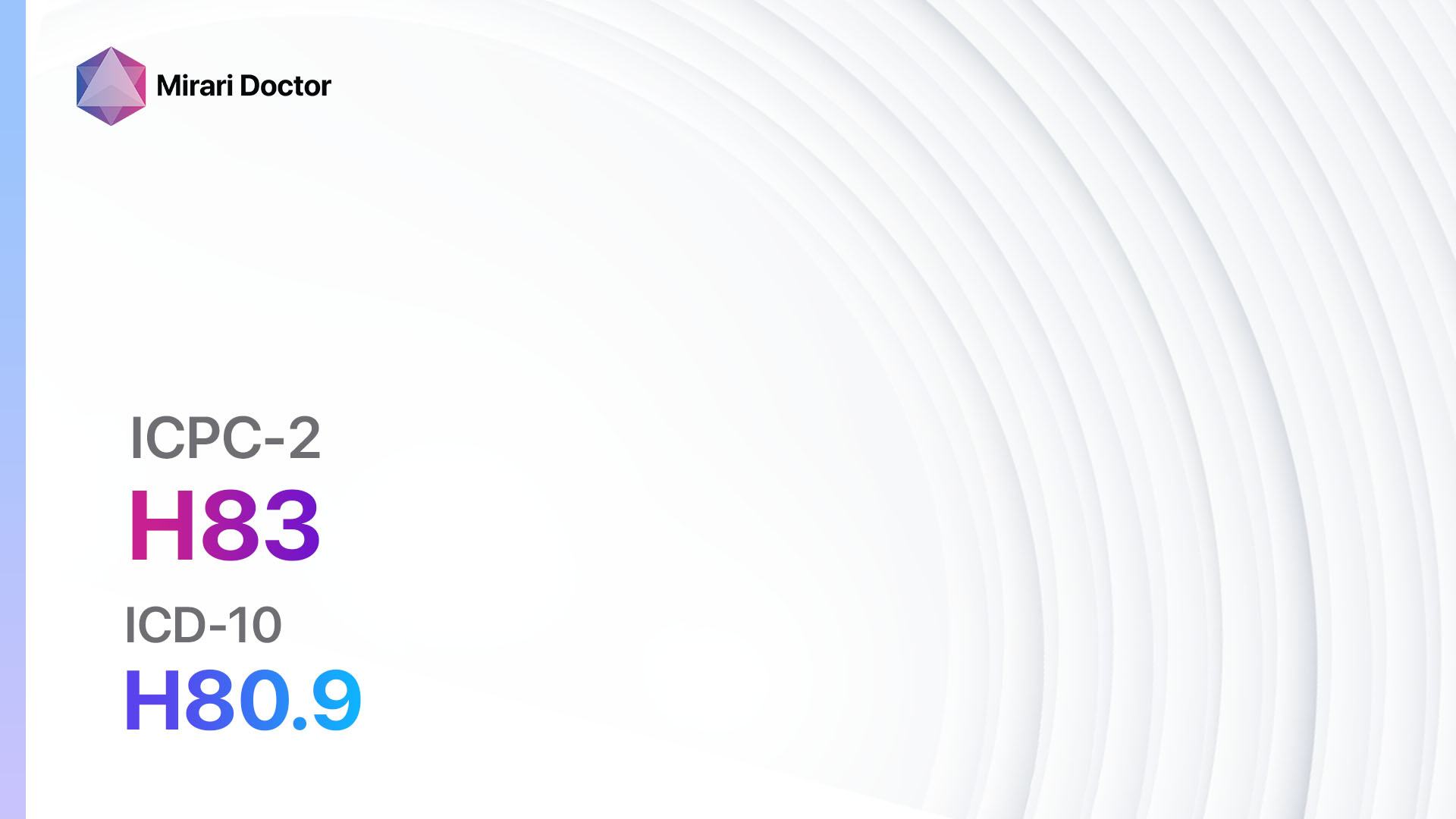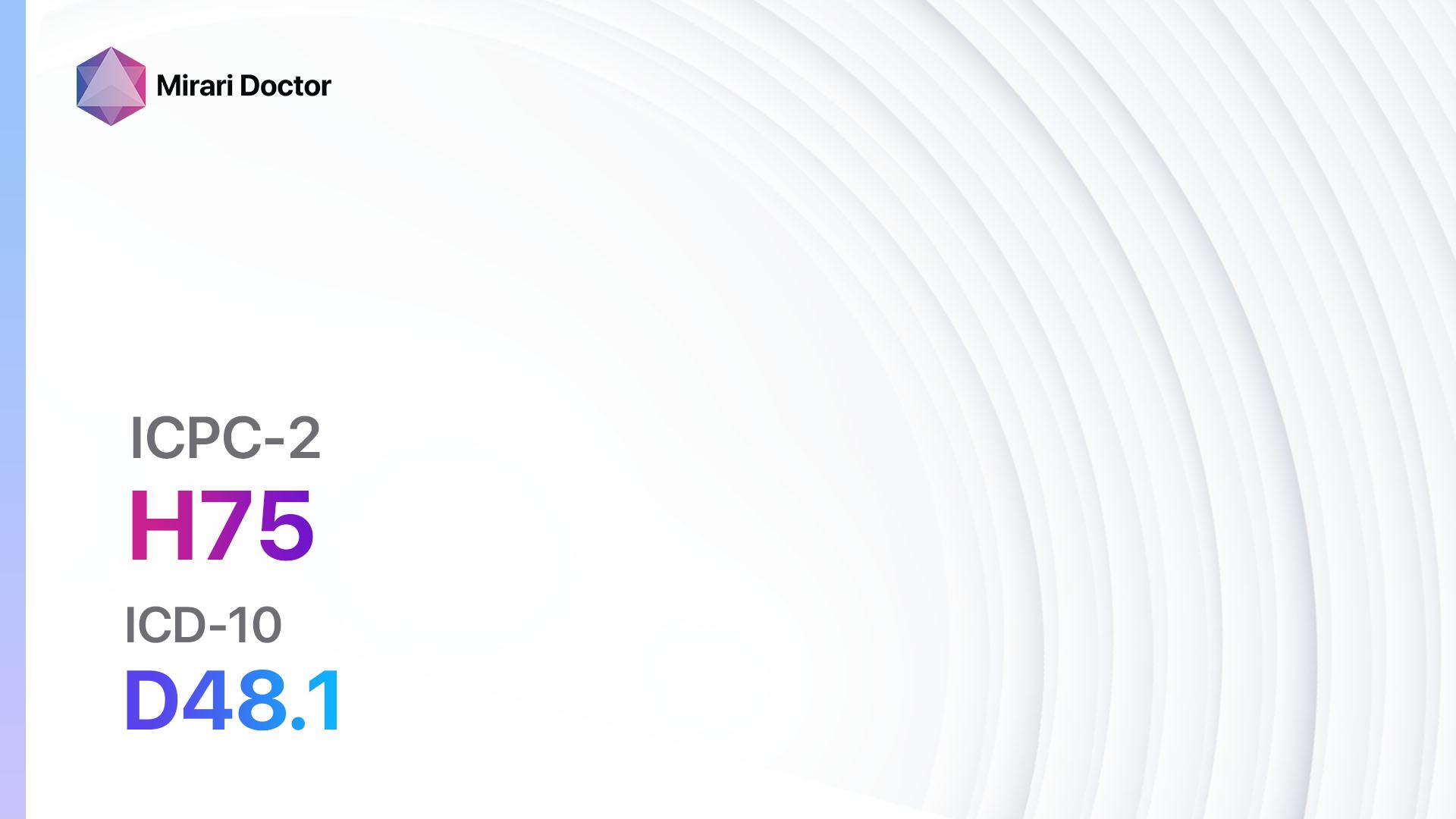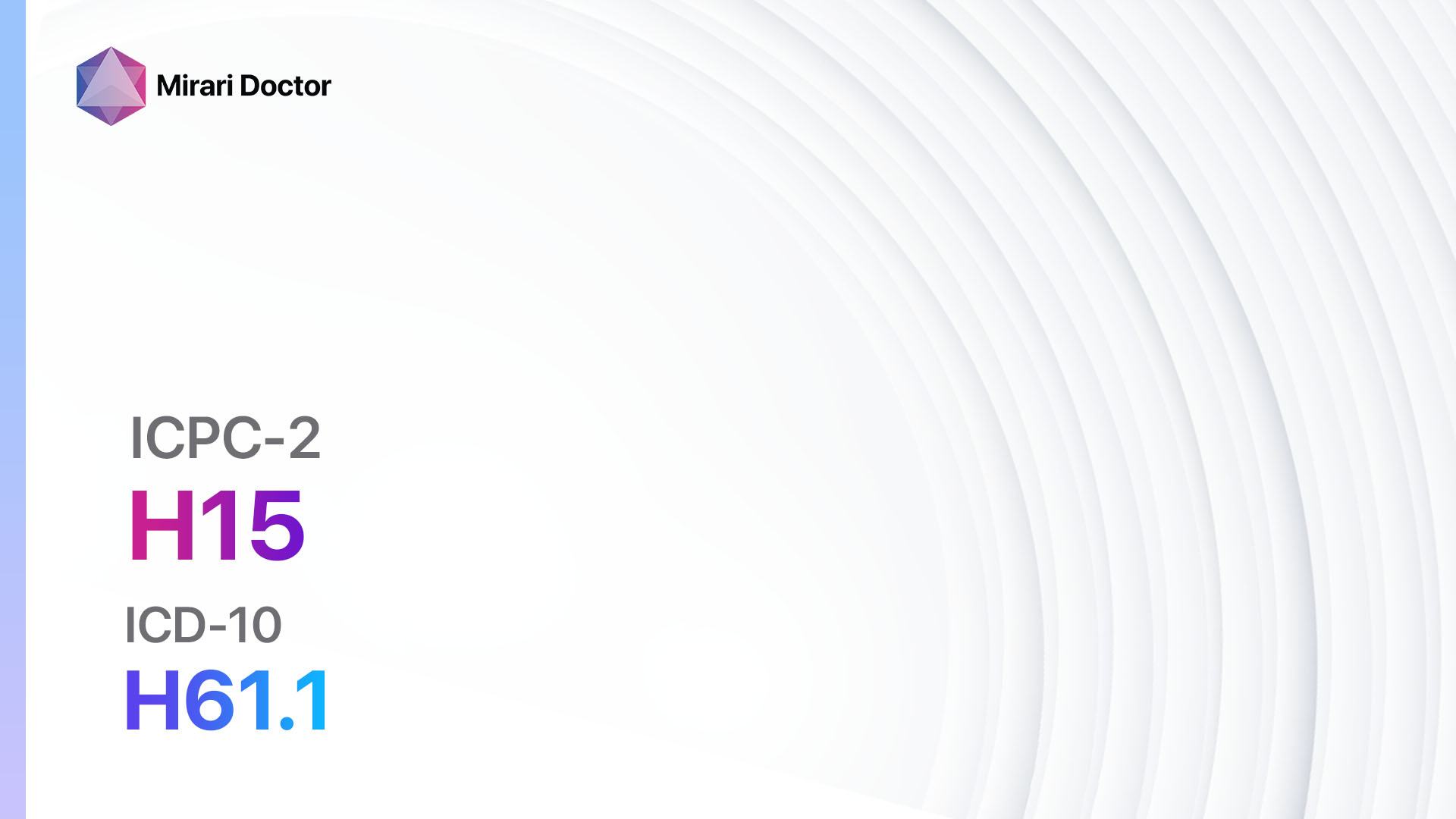
Introduction
Chronic otitis media is a long-term inflammation of the middle ear that can cause persistent ear pain, hearing loss, and other complications.[1] It is a significant condition as it can lead to permanent hearing loss if left untreated.[2] The aim of this guide is to provide healthcare professionals with a comprehensive overview of the diagnostic steps, possible interventions, and patient education for chronic otitis media.
Codes
- ICPC-2 Code: H74 Chronic otitis media
- ICD-10 Code: H66.3 Other chronic suppurative otitis media
Symptoms
- Ear pain: Persistent or recurrent pain in the affected ear.[3]
- Hearing loss: Partial or complete loss of hearing in the affected ear.[4]
- Ear drainage: Fluid or pus draining from the ear.[5]
- Tinnitus: Ringing or buzzing sound in the ear.[6]
- Feeling of fullness in the ear: Sensation of pressure or blockage in the affected ear.[7]
Causes
- Bacterial or viral infection: Infections can lead to inflammation and fluid buildup in the middle ear.[8]
- Eustachian tube dysfunction: Dysfunction of the tube that connects the middle ear to the back of the throat can cause fluid buildup.[9]
- Allergies: Allergic reactions can cause inflammation and fluid buildup in the middle ear.[10]
- Structural abnormalities: Abnormalities in the structure of the middle ear can contribute to chronic otitis media.
Diagnostic Steps
Medical History
- Gather information about the patient’s symptoms, including the duration and severity of ear pain, hearing loss, and other associated symptoms.
- Ask about any previous episodes of otitis media or ear infections.
- Inquire about any risk factors, such as exposure to secondhand smoke or a history of allergies.
Physical Examination
- Inspect the external ear for any signs of inflammation, discharge, or structural abnormalities.
- Perform otoscopy to examine the ear canal and eardrum for signs of infection, fluid buildup, or perforation.
- Assess the patient’s hearing using a tuning fork or audiometry.
Laboratory Tests
- Complete blood count (CBC): To check for signs of infection or inflammation.
- C-reactive protein (CRP) test: To assess the level of inflammation in the body.
- Allergy testing: To identify any allergens that may be contributing to the condition.
Diagnostic Imaging
- High-resolution computed tomography (CT) scan: To evaluate the structures of the middle ear and detect any abnormalities.
- Magnetic resonance imaging (MRI): To assess the extent of damage or complications, such as cholesteatoma.
Other Tests
- Tympanometry: To measure the movement of the eardrum and assess middle ear function.
- Cultures of ear discharge: To identify the specific bacteria or viruses causing the infection.
- Audiometry: To determine the extent and type of hearing loss.
Follow-up and Patient Education
- Schedule regular follow-up appointments to monitor the progress of treatment and assess any complications.
- Educate the patient about the importance of completing the full course of antibiotics if prescribed.
- Provide information on preventive measures, such as avoiding exposure to secondhand smoke and practicing good hygiene.
Possible Interventions
Traditional Interventions
Medications:
Top 5 drugs for Chronic otitis media:
- Antibiotics (e.g., Amoxicillin, Ciprofloxacin, Azithromycin):
- Cost: Generic versions can be $3-$50/month.
- Contraindications: Hypersensitivity to antibiotics.
- Side effects: Nausea, diarrhea, allergic reactions.
- Severe side effects: Severe allergic reactions, tendon rupture.
- Drug interactions: Warfarin, antacids.
- Warning: Complete the full course of antibiotics as prescribed.
- Corticosteroids (e.g., Prednisone, Dexamethasone):
- Cost: Generic versions can be $5-$50/month.
- Contraindications: Active infections, systemic fungal infections.
- Side effects: Increased appetite, weight gain, mood changes.
- Severe side effects: Adrenal suppression, osteoporosis.
- Drug interactions: Nonsteroidal anti-inflammatory drugs (NSAIDs), anticoagulants.
- Warning: Do not abruptly stop taking corticosteroids.
- Decongestants (e.g., Pseudoephedrine, Phenylephrine):
- Cost: Generic versions can be $5-$20/month.
- Contraindications: High blood pressure, heart disease.
- Side effects: Increased heart rate, insomnia, nervousness.
- Severe side effects: Severe allergic reactions, heart attack.
- Drug interactions: Monoamine oxidase inhibitors (MAOIs), beta-blockers.
- Warning: Limit use to short-term relief of symptoms.
- Antihistamines (e.g., Loratadine, Cetirizine):
- Cost: Generic versions can be $5-$20/month.
- Contraindications: Glaucoma, urinary retention.
- Side effects: Drowsiness, dry mouth, blurred vision.
- Severe side effects: Severe allergic reactions, irregular heartbeat.
- Drug interactions: Sedatives, alcohol.
- Warning: Avoid driving or operating machinery while taking antihistamines.
- Analgesics (e.g., Acetaminophen, Ibuprofen):
- Cost: Generic versions can be $3-$10/month.
- Contraindications: Liver disease, bleeding disorders.
- Side effects: Upset stomach, liver damage (with high doses).
- Severe side effects: Severe allergic reactions, kidney damage.
- Drug interactions: Warfarin, aspirin.
- Warning: Follow recommended dosage and avoid exceeding the maximum daily dose.
Alternative Drugs:
- Antifungal agents (e.g., Fluconazole): Used if a fungal infection is suspected.
- Antiviral agents (e.g., Acyclovir): Used if a viral infection is suspected.
- Mastoidectomy: Surgical removal of infected mastoid air cells. Cost: $10,000 to $30,000.
- Tympanoplasty: Surgical repair of the eardrum. Cost: $5,000 to $15,000.
Surgical Procedures:
- Tympanostomy tube placement: Insertion of small tubes into the eardrums to allow drainage and ventilation. Cost: $2,000 to $5,000.
- Mastoidectomy: Surgical removal of infected mastoid air cells. Cost: $10,000 to $30,000.
- Tympanoplasty: Surgical repair of the eardrum. Cost: $5,000 to $15,000.
Alternative Interventions
- Acupuncture: May help reduce pain and inflammation. Cost: $60-$120 per session.
- Herbal remedies: Some herbs, such as garlic and mullein, may have antimicrobial and anti-inflammatory properties. Cost: Varies depending on the specific herb and preparation.
- Homeopathic remedies: Homeopathic treatments, such as Pulsatilla and Silicea, may be used to alleviate symptoms. Cost: Varies depending on the specific remedy and brand.
- Chiropractic care: Spinal adjustments and manipulations may help improve Eustachian tube function. Cost: $50-$200 per session.
- Probiotics: Certain strains of probiotics may help boost the immune system and reduce the risk of recurrent infections. Cost: Varies depending on the brand and formulation.
Lifestyle Interventions
- Avoiding irritants: Encourage the patient to avoid exposure to cigarette smoke, allergens, and other irritants that can worsen symptoms.
- Maintaining good hygiene: Emphasize the importance of regular handwashing and proper cleaning of the ears to prevent infections.
- Using ear protection: Advise the patient to use earplugs or earmuffs in noisy environments to protect the ears from further damage.
- Practicing nasal irrigation: Nasal irrigation with saline solution can help clear the nasal passages and improve Eustachian tube function. Cost: $10-$20 for a nasal irrigation kit.
- Stress management: Stress can weaken the immune system, so encourage the patient to engage in stress-reducing activities, such as exercise, meditation, or counseling. Cost: Varies depending on the chosen activity or therapy.
It is important to note that the cost ranges provided are approximate and may vary depending on the location and availability of the interventions.
Mirari Cold Plasma Alternative Intervention
Understanding Mirari Cold Plasma
- Safe and Non-Invasive Treatment: Mirari Cold Plasma is a safe and non-invasive treatment option for various skin conditions. It does not require incisions, minimizing the risk of scarring, bleeding, or tissue damage.
- Efficient Extraction of Foreign Bodies: Mirari Cold Plasma facilitates the removal of foreign bodies from the skin by degrading and dissociating organic matter, allowing easier access and extraction.
- Pain Reduction and Comfort: Mirari Cold Plasma has a local analgesic effect, providing pain relief during the treatment, making it more comfortable for the patient.
- Reduced Risk of Infection: Mirari Cold Plasma has antimicrobial properties, effectively killing bacteria and reducing the risk of infection.
- Accelerated Healing and Minimal Scarring: Mirari Cold Plasma stimulates wound healing and tissue regeneration, reducing healing time and minimizing the formation of scars.
Mirari Cold Plasma Prescription
Video instructions for using Mirari Cold Plasma Device – H74 Chronic otitis media (ICD-10:H66.3)
| Mild | Moderate | Severe |
| Mode setting: 1 (Infection) Location: 0 (Localized) Morning: 15 minutes, Evening: 15 minutes |
Mode setting: 1 (Infection) Location: 0 (Localized) Morning: 30 minutes, Lunch: 30 minutes, Evening: 30 minutes |
Mode setting: 1 (Infection) Location: 0 (Localized) Morning: 30 minutes, Lunch: 30 minutes, Evening: 30 minutes |
| Mode setting: 2 (Wound Healing) Location: 0 (Localized) Morning: 15 minutes, Evening: 15 minutes |
Mode setting: 2 (Wound Healing) Location: 0 (Localized) Morning: 30 minutes, Lunch: 30 minutes, Evening: 30 minutes |
Mode setting: 2 (Wound Healing) Location: 0 (Localized) Morning: 30 minutes, Lunch: 30 minutes, Evening: 30 minutes |
| Mode setting: 3 (Antiviral Therapy) Location: 0 (Localized) Morning: 15 minutes, Evening: 15 minutes |
Mode setting: 3 (Antiviral Therapy) Location: 0 (Localized) Morning: 30 minutes, Lunch: 30 minutes, Evening: 30 minutes |
Mode setting: 3 (Antiviral Therapy) Location: 0 (Localized) Morning: 30 minutes, Lunch: 30 minutes, Evening: 30 minutes |
| Total Morning: 45 minutes approx. $7.50 USD, Evening: 45 minutes approx. $7.50 USD |
Total Morning: 90 minutes approx. $15 USD, Lunch: 90 minutes approx. $15 USD, Evening: 90 minutes approx. $15 USD, |
Total Morning: 90 minutes approx. $15 USD, Lunch: 90 minutes approx. $15 USD, Evening: 90 minutes approx. $15 USD, |
| Usual treatment for 7-60 days approx. $105 USD – $900 USD | Usual treatment for 6-8 weeks approx. $1,890 USD – $2,520 USD |
Usual treatment for 3-6 months approx. $4,050 USD – $8,100 USD
|
 |
|
Use the Mirari Cold Plasma device to treat Chronic otitis media effectively.
WARNING: MIRARI COLD PLASMA IS DESIGNED FOR THE HUMAN BODY WITHOUT ANY ARTIFICIAL OR THIRD PARTY PRODUCTS. USE OF OTHER PRODUCTS IN COMBINATION WITH MIRARI COLD PLASMA MAY CAUSE UNPREDICTABLE EFFECTS, HARM OR INJURY. PLEASE CONSULT A MEDICAL PROFESSIONAL BEFORE COMBINING ANY OTHER PRODUCTS WITH USE OF MIRARI.
Step 1: Cleanse the Skin
- Start by cleaning the affected area of the skin with a gentle cleanser or mild soap and water. Gently pat the area dry with a clean towel.
Step 2: Prepare the Mirari Cold Plasma device
- Ensure that the Mirari Cold Plasma device is fully charged or has fresh batteries as per the manufacturer’s instructions. Make sure the device is clean and in good working condition.
- Switch on the Mirari device using the power button or by following the specific instructions provided with the device.
- Some Mirari devices may have adjustable settings for intensity or treatment duration. Follow the manufacturer’s instructions to select the appropriate settings based on your needs and the recommended guidelines.
Step 3: Apply the Device
- Place the Mirari device in direct contact with the affected area of the skin. Gently glide or hold the device over the skin surface, ensuring even coverage of the area experiencing.
- Slowly move the Mirari device in a circular motion or follow a specific pattern as indicated in the user manual. This helps ensure thorough treatment coverage.
Step 4: Monitor and Assess:
- Keep track of your progress and evaluate the effectiveness of the Mirari device in managing your Chronic otitis media. If you have any concerns or notice any adverse reactions, consult with your health care professional.
Note
This guide is for informational purposes only and should not replace the advice of a medical professional. Always consult with your healthcare provider or a qualified medical professional for personal advice, diagnosis, or treatment. Do not solely rely on the information presented here for decisions about your health. Use of this information is at your own risk. The authors of this guide, nor any associated entities or platforms, are not responsible for any potential adverse effects or outcomes based on the content.
Mirari Cold Plasma System Disclaimer
- Purpose: The Mirari Cold Plasma System is a Class 2 medical device designed for use by trained healthcare professionals. It is registered for use in Thailand and Vietnam. It is not intended for use outside of these locations.
- Informational Use: The content and information provided with the device are for educational and informational purposes only. They are not a substitute for professional medical advice or care.
- Variable Outcomes: While the device is approved for specific uses, individual outcomes can differ. We do not assert or guarantee specific medical outcomes.
- Consultation: Prior to utilizing the device or making decisions based on its content, it is essential to consult with a Certified Mirari Tele-Therapist and your medical healthcare provider regarding specific protocols.
- Liability: By using this device, users are acknowledging and accepting all potential risks. Neither the manufacturer nor the distributor will be held accountable for any adverse reactions, injuries, or damages stemming from its use.
- Geographical Availability: This device has received approval for designated purposes by the Thai and Vietnam FDA. As of now, outside of Thailand and Vietnam, the Mirari Cold Plasma System is not available for purchase or use.
References
- Acuin J. Chronic suppurative otitis media: burden of illness and management options. World Health Organization; 2004.
- Monasta L, Ronfani L, Marchetti F, et al. Burden of disease caused by otitis media: systematic review and global estimates. PLoS One. 2012;7(4):e36226. doi:10.1371/journal.pone.0036226
- Lieberthal AS, Carroll AE, Chonmaitree T, et al. The diagnosis and management of acute otitis media. Pediatrics. 2013;131(3):e964-e999. doi:10.1542/peds.2012-3488
- Cureoglu S, Schachern PA, Paparella MM, Lindgren BR. Cochlear changes in chronic otitis media. Laryngoscope. 2004;114(4):622-626. doi:10.1097/00005537-200404000-00006
- Verhoeff M, van der Veen EL, Rovers MM, Sanders EA, Schilder AG. Chronic suppurative otitis media: a review. Int J Pediatr Otorhinolaryngol. 2006;70(1):1-12. doi:10.1016/j.ijporl.2005.08.021
- Baguley DM. Mechanisms of tinnitus. Br Med Bull. 2002;63:195-212. doi:10.1093/bmb/63.1.195
- Bluestone CD. Pathogenesis of otitis media: role of eustachian tube. Pediatr Infect Dis J. 1996;15(4):281-291. doi:10.1097/00006454-199604000-00002
- Rovers MM, Schilder AG, Zielhuis GA, Rosenfeld RM. Otitis media. Lancet. 2004;363(9407):465-473. doi:10.1016/S0140-6736(04)15495-0
- Bluestone CD, Klein JO. Otitis Media in Infants and Children. 4th ed. Hamilton, Ontario: BC Decker Inc; 2007.
- Lack G, Caulfield H, Penagos M. The link between otitis media with effusion and allergy: a potential role for intranasal corticosteroids. Pediatr Allergy Immunol. 2011;22(3):258-266. doi:10.1111/j.1399-3038.2010.01120.x
Related articles
Made in USA



























